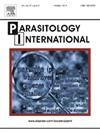New freshwater Ceratomyxa species, Ceratomyxa schwanefeldii n. sp. (Myxozoa: Ceratomyxidae) from the gall bladder of tinfoil barb, Barbonymus schwanefeldii (Cyprinidae, Cypriniformes) in Malaysia
IF 1.5
4区 医学
Q3 PARASITOLOGY
引用次数: 0
Abstract
Genus Ceratomyxa comprises coelozoic parasites of mainly marine and brackish water fish. This study describes a new Ceratomyxa species, Ceratomyxa schwanefeldii n. sp. which parasitizes the gall bladder of Barbonymus schwanefeldii collected from Sungai Tong in Setiu, Terengganu, Malaysia. The new species was described using morphological characteristics, and on nucleotide sequences of small subunit ribosomal DNA (SSU rDNA) and large subunit ribosomal DNA (LSU rDNA). Ceratomyxa schwanefeldii n. sp. exhibited vermiform shape plasmodia with slow undulatory motility, measuring 151.6 ± 86.0 (43.0–271.0) μm in length and 15.1 ± 4.8 (9.3–22.7) μm in width, with blunt poles at both ends. The mature spores were crescent-shaped, strongly arched in frontal view, with a sutural line between the two valves tapering to blunt ends. Formalin-fixed spores were 3.0 ± 0.4 (2.4–3.9) μm in length, 12.6 ± 1.2 (10.8–15.4) μm in thickness, with a concave posterior angle, 104.8° ± 10.2° (73.4–123.8). Two equal-sized spheroid polar capsules measured 1.5 ± 0.2 (1.2–1.8) μm in length and 1.3 ± 0.2 (0.9–1.7) μm in width. Phylogenetic analyses by Maximum likelihood and Bayesian Inference algorithms positioned C. schwanefeldii n. sp. as a sister species to Unicapsulocaudum mugilum and clustered within the clade of Amazonian freshwater Ceratomyxa species. The LSU rDNA phylogeny revealed that C. schwanefeldii n. sp. clusters within the marine Ceratomyxa clade and forms a sister relationship with C. leatherjacketi. This study represents the first description of a freshwater Ceratomyxa in Malaysia and the fourth recorded detection in the Asian region.

马来西亚淡水角鼻蝇新种,schwanefeldii n. sp.(粘虫目:角鼻蝇科)来自锡纸刺瘿,schwanefeldii(鲤科,鲤形目)
角鼻虫属主要由海洋和咸淡水鱼类的古生代寄生虫组成。本研究报道了一种寄生于马来西亚登嘉诺泗提乌Sungai Tong schwanefeldii Barbonymus胆囊的角蝇新种——schwanefeldii . sp.。利用形态学特征、小亚基核糖体DNA (SSU rDNA)和大亚基核糖体DNA (LSU rDNA)的核苷酸序列对新种进行了描述。schwanefeldii . spp .为蚓状,长151.6±86.0 (43.0-271.0)μm,宽15.1±4.8 (9.3-22.7)μm,两端呈钝极,具有缓慢的波动运动。成熟孢子呈月牙形,正面呈拱形,两瓣间有缝合线,两端逐渐变细。孢子长3.0±0.4 (2.4 ~ 3.9)μm,厚12.6±1.2 (10.8 ~ 15.4)μm,后凹角104.8°±10.2°(73.4 ~ 123.8)。两个等尺寸的球体极性胶囊的长度为1.5±0.2 (1.2-1.8)μm,宽度为1.3±0.2 (0.9-1.7)μm。利用最大似然和贝叶斯推理算法进行系统发育分析,将C. schwanefeldii n. sp定位为Unicapsulocaudum mugilum的姐妹种,并聚在亚马逊淡水角鼻虫种的分支中。LSU rDNA系统发育表明,C. schwanefeldii n. sp.属于海洋角鼻门分支,并与C. leatherjacketi形成姐妹关系。这项研究代表了马来西亚淡水角鼻虫的首次描述,也是亚洲地区第四次记录的检测。
本文章由计算机程序翻译,如有差异,请以英文原文为准。
求助全文
约1分钟内获得全文
求助全文
来源期刊

Parasitology International
医学-寄生虫学
CiteScore
4.00
自引率
10.50%
发文量
140
审稿时长
61 days
期刊介绍:
Parasitology International provides a medium for rapid, carefully reviewed publications in the field of human and animal parasitology. Original papers, rapid communications, and original case reports from all geographical areas and covering all parasitological disciplines, including structure, immunology, cell biology, biochemistry, molecular biology, and systematics, may be submitted. Reviews on recent developments are invited regularly, but suggestions in this respect are welcome. Letters to the Editor commenting on any aspect of the Journal are also welcome.
 求助内容:
求助内容: 应助结果提醒方式:
应助结果提醒方式:


